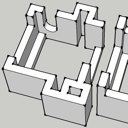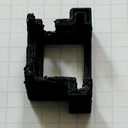Blatant Fabrication October 2, 2009
I made my first tentative steps into the world of desktop manufacturing last night. Having a couple of small servo motors, I thought it would be cool to make a tiny pan/tilt rig with them. I also thought this would be a good first 3D printing project. A couple months ago, several of us at W&B got together and built a Makerbot*, a small hobbyist’s 3D printer based on the RepRap project. Like RepRap, the Makerbot fabricates objects out of extruded ABS plastic, the same stuff of which LEGO blocks are made.
The Makerbot fabricates things by laying down a thin bead of molten plastic onto a small platform. The platform moves in two dimensions beneath the extruder, creating a cross-section of the model being built. After one cross-section is complete, the extruder rises and the next cross-section begins. It is a little like creating something from cake icing — I wonder if that’s the origin of the Cupcake name.
The end results aren’t always very pretty; the machine’s accuracy is somewhat limited (there’s only so much control one can have over semi-liquid plastic) and fabbed objects have a somewhat fibrous texture. The open air construction also makes it difficult to create objects with closed vertical openings or overhangs, but it can be done reasonably well by building chamfers or arches to support the overhanging parts.
My own first try was only marginally successful. I designed holders for the vertical (top) and horizontal (base) servo motors in SketchUp, a nice program for sketching out geometric/architectural shapes in 3D. SketchUp has been around a while, but Google bought it a while back and released a free edition. From SketchUp, the model was exported as STL (stereolithograph) files and then converted to GCode (the standard language for driving CNC devices) via Skeinforge. This was then fed to the machine. In about twenty minutes, I had a pair of slightly lumpy plastic objects.
On the one hand, I actually turned a set of data into a physical object, which is pretty incredible when you think of it. On the other hand, the servos don’t fit the holders, so this first draft is useless. I think I made the model too precise, not properly accounting for either the eccentricities of the gooey plastic thread or the slight shrinkage of the object as it cooled. Some cleanup is to be expected — some trimming with a razor blade here, a bit of sanding/filing there — but as tight as these models are, it would be nearly as much work to carve new ones by hand from scratch.
I’m headed back to W&B this afternoon to build some more workbenches for the new members, so I think I’ll set the machine printing version 2.0 while I work. Hopefully, with these lessons learned, the next ones will turn out better.
(* Technically, the machine is called Cupcake CNC and the company that makes it is Makerbot, but the two names appear to be used interchangeably, like ‘Apple’ and ‘Mac.’)


Leave a Reply
You must be logged in to post a comment.